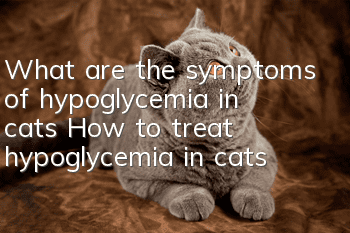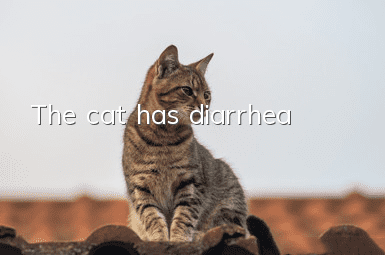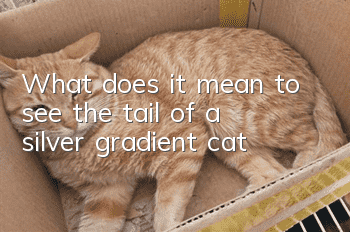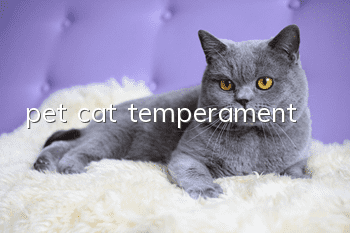What are the symptoms of hypoglycemia in cats? (How to treat hypoglycemia in cats?)

About hypoglycemia. As the name suggests, hypoglycemia is a disease of lack of blood sugar. So what's the problem with hypoglycemia? The blood contains a certain amount of sugar (glucose), and the glucose contained in meals is used as an energy source for cells throughout the body. Because too high a concentration of glucose is harmful to the body, the part not used as an energy source is converted into "glycogen" and stored in muscles, or converted into neutral fat and stored. There are fewer glucose routes entering, and less glycogen is stored. If the insulin used in diabetes treatment (the hormone that causes it to store glucose routes) becomes too effective, there will be fewer glucose routes in the blood, and cells throughout the body will begin to fail. Work can also cause various diseases.
If a cat suffers from hypoglycemia, what symptoms will appear, are they likely to be life-threatening?
Causes of hypoglycemia in cats The causes of hypoglycemia vary depending on the age of the cat and the disease it has. Kittens and puppies are known to be susceptible to hypoglycemia. The liver and muscles used to store glycogen are underdeveloped, and the brain mass (glucose consumption is large) in proportion to the body, so they tend to be more susceptible to hypoglycemia than adult cats and dogs. Condition in Adult Cats In adult cats, it is caused by overproduction of insulin when the insulin used to treat diabetes becomes too effective, or when the insulin develops tumors in the pancreas, an organ that secretes insulin.
Symptoms of hypoglycemia in cats: Common symptoms of hypoglycemia include the following. Convulsions, low body temperature, depression, soft sleep, confused thoughts, weakness in limbs, vomiting, diarrhea, loss of appetite, symptoms of dehydration, rapid heartbeat, shortness of breath, and staggering walking. As mentioned above, glucose is the energy source for cells throughout the body. Particularly in the brain, because most of the energy supply is based on glucose, hypoglycemia often causes symptoms related to cranial nerves and often results in life-threatening symptoms.
Treating hypoglycemia in cats
In the case of kittens, if low body temperature is observed, instill glucose while maintaining warmth. Antimicrobial agents can be used in combination with symptomatic treatment. If symptoms of hypoglycemia occur in the case of insulinoma, secure the vessel and inject glucose. Additionally, if your cat can take glucose by mouth, your doctor will do so. The veterinarian will perform medical treatment or surgical treatment to comprehensively determine the degree of dehydration and the cat's physical condition. If medical treatment cannot control hypoglycemia, surgery will be performed.
Surgery to remove the tumor is performed when the cat feels well enough to resist surgery. In the case of diabetes, insulin does not work properly in the body for some reason, so injecting insulin and controlling diet to prevent high blood sugar are the basic treatments for diabetes. However, in some cases, too much insulin may cause hypoglycemia, or it may be in the immediate aftermath of hyperglycemia.state. Therefore, the timing of blood collection to monitor hypoglycemia due to diabetes also becomes important. When symptoms of hypoglycemia are severe, glucose can be infused, and if symptoms such as dehydration occur, correction can also be made. At the same time, the cat was given an appropriate amount of insulin supplement, and multiple insulin and blood glucose levels were measured.
Most hypoglycemia is due to malnutrition. The amount of food you eat depends on your age and weight. Please refer to the recommendations on the packaging bag, not the N tablets recommended by the pet store. We must ensure that puppies and cats eat at least three to four times a day, feed multiple small amounts, and feed high-quality dog food suitable for young animals.
Summary: Cat hypoglycemia is also a relatively dangerous disease. The time for treatment is more important. If it is delayed, it will cause life-threatening consequences. Therefore, all new parents of small animals must pay attention to their babies. Whether the patient is emaciated, the ribs are not obvious to the touch, the gums are red but not pale, and whether there are sub-health conditions such as vomiting, diarrhea or coughing. If you find any abnormality, please take it to the hospital for treatment as soon as possible to avoid irreparable damage.
- How to treat stomatitis in cats
- How to train a cat not to bite
- Can kittens eat egg yolks?
- How to train a cat not to jump on the bed? Change your living habits!
- Why do cats like to curl up in a ball?
- Can cats eat peanuts?
- What do California Shiny Cats eat? Feeding Guide for California Shiny Cats
- How to raise a Siamese cat Raising a Siamese cat needs to be serious and careful!
- Can Fold-eared cats eat Wangzai?
- Where can I adopt a cat? Is it free?



